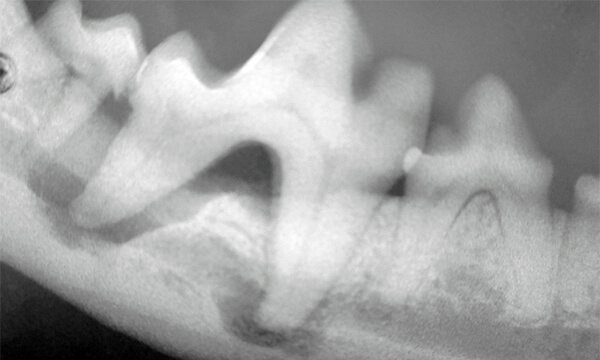
How do I know if my pet has dental disease?
This decision is best made in consultation with one of our veterinarians. Indications that your pet may be suffering from dental disease are bad breath, plaque build-up, gingivitis, tooth fractures and tooth resorption (more on this below). It is rare that pets will give their guardians an indication that their teeth hurt, such as teeth-chattering or refusing to eat. In most cases pets will continue to eat normally even in the face of significant dental disease.
What happens when my pet gets a “dental?”
When we do dental work pets must be under general anesthesia to allow us to take full mouth radiographs and get a complete oral exam. Just like when you go to the dentist, we measure gingival pocket depths with a dental probe. Based on radiographic, visual and tactile exam of the teeth we decide what treatment is needed to keep the pet comfortable and happy and reduce the chance of further dental problems in the future. We use an ultrasonic scaler to clean all the teeth, including under the gumline, and finish up with a polish. All pets get aquapuncture (injection of vitamin B12 at acupuncture points) to help them recover from anesthesia. Pets go home when they are fully awake, just a few hours later.
I get awake dental cleanings done at the pet store and the teeth look great. Isn’t this enough?
During an awake dental cleaning, the visible tartar is cleaned off the teeth and the teeth are polished. This may make a pet’s teeth look nice, but its effectiveness at addressing dental pathology is somewhere between a good brushing and a hygenist’s cleaning. An anesthetic dental procedure is analogous to all visits to your dentist within a year or two – dental radiographs are taken and all problem teeth are identified and treated on the same day. Our pets could never sit still for the thorough cleaning and exam under the gumline that happens at your dental office, nor can they sit still for dental radiographs (think of how hard this is for you to sit still through). The photos below are taken from a recent routine dental procedure. On the left is a photo taken after cleaning, and on cursory visual exam the teeth look great. On the right, an x-ray image of the same teeth reveals abscesses (pockets of pus) on both roots of the large tooth in the photo. If left untreated this would continue be a constant source of pain and infection for the dog, and lead to more problems in the future. Without a complete exam and radiographs, we never would have known this pet was in pain

appears normal on visual
examination.

tooth. Note tooth root
abscesses.
What is tooth resorption? How do I know if my pet has tooth resorption?
Tooth resorption is a painful process with no known cause. It occurs in up to 50% of cats and many dogs as well. The cat or dog’s own body initiates destruction of one or more teeth from the outside in, resulting in pain and periodontal disease. The only treatment is removal of the affected teeth to alleviate pain associated with the process. Many cats show no discernible signs of their resorptive lesions but are more active and happier after treatment. It is very important to understand that though some resorptive lesions are visible on exam, many are hidden under the gumline or under severe tartar buildup, making the diagnosis impossible without dental radiographs (x-rays).

How much will a dental procedure cost?
The cost of a dental procedure varies a lot and is primarily based on the time it takes. Dental procedures are as expensive as they are because of the state-of-the art dental and monitoring equipment and expert staff required. Because so much dental disease is discovered at the time of the procedure it is difficult to provide an exact estimate ahead of time.